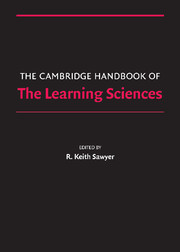Book contents
- Frontmatter
- Contents
- Preface
- Contributors
- 1 Introduction
- PART I FOUNDATIONS
- PART II METHODOLOGIES
- PART III THE NATURE OF KNOWLEDGE
- PART IV MAKING KNOWLEDGE VISIBLE
- PART V LEARNING TOGETHER
- 24 Computer-Supported Collaborative Learning
- 25 WILD for Learning
- 26 Arguing to Learn
- 27 Learning in Online Communities
- PART VI LEARNING ENVIRONMENTS
- Afterword: After How Comes What
- Epilogue: The Fundamental Issue in the Learning Sciences
- Author Index
- Subject Index
- References
27 - Learning in Online Communities
Published online by Cambridge University Press: 05 June 2012
- Frontmatter
- Contents
- Preface
- Contributors
- 1 Introduction
- PART I FOUNDATIONS
- PART II METHODOLOGIES
- PART III THE NATURE OF KNOWLEDGE
- PART IV MAKING KNOWLEDGE VISIBLE
- PART V LEARNING TOGETHER
- 24 Computer-Supported Collaborative Learning
- 25 WILD for Learning
- 26 Arguing to Learn
- 27 Learning in Online Communities
- PART VI LEARNING ENVIRONMENTS
- Afterword: After How Comes What
- Epilogue: The Fundamental Issue in the Learning Sciences
- Author Index
- Subject Index
- References
Summary
John Dewey wrote that “Education is not preparation for life; education is life itself” (Dewey, 1938). Dewey argued that learning communities should not be a world apart, but instead integrated with the rest of society. Students should be encouraged to be a part of civil society, pursuing interests in collaboration with others. More than fifty years later, Scardamalia and Bereiter (1994) articulated a similar vision, and noted that computer-mediated communication (CMC) creates new possibilities for building learning communities that are deeply integrated with society. “Computer-mediated communication” refers to communication between people that occurs through the medium of the computer, and includes email, instant messages, chat rooms, newsgroups, and blogs. Learning sciences researchers have made great progress in understanding how CMC can be used to connect learners together, and to allow learners to connect with society at large.
Learning takes place especially felicitously as part of a knowledge-building community (Scardamalia & Bereiter, 1994) that brings together people of all ages and diverse social roles. Scardamalia and Bereiter comment,
[I]t is fanciful (but nonetheless exciting) to contemplate advantages of having communal structures that span the whole of the school years and that also profitably engage those in research institutes and other knowledge-creation enterprises. The fancifulness is not with the technology – recent developments make that by far the easy part. The problems to be solved are educational.
(Scardamalia & Bereiter, 1994, p. 276)- Type
- Chapter
- Information
- The Cambridge Handbook of the Learning Sciences , pp. 461 - 472Publisher: Cambridge University PressPrint publication year: 2005
References
- 5
- Cited by



